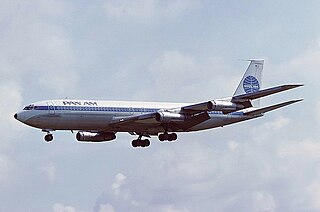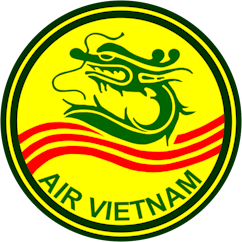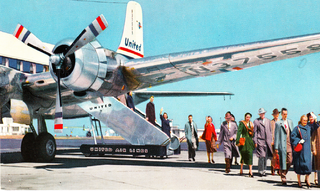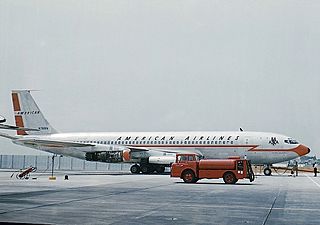
The Boeing 707 is an early American long-range narrow-body airliner, the first jetliner developed and produced by Boeing Commercial Airplanes. Developed from the Boeing 367-80 prototype first flown in 1954, the initial 707-120 first flew on December 20, 1957. Pan Am began regular 707 service on October 26, 1958. With versions produced until 1979, the 707 was a swept wing quadjet with podded engines. Its larger fuselage cross-section allowed six-abreast economy seating, retained in the later 720, 727, 737, and 757 models.

The Convair 880 is a retired American narrow-body jet airliner produced by the Convair division of General Dynamics. It was designed to compete with the Boeing 707 and Douglas DC-8 by being smaller but faster, a niche that failed to create demand. When it was first introduced, some in aviation circles claimed that at 615 mph (990 km/h), it was the fastest jet transport in the world. Only 65 Convair 880s were produced over the lifetime of the production run from 1959 to 1962, and General Dynamics eventually withdrew from the airliner market after considering the 880 project a failure. The Convair 990 Coronado was a stretched and faster variant of the 880.

The Convair 990 Coronado is a retired American narrow-body four-engined jet airliner produced between 1961 and 1963 by the Convair division of American company General Dynamics. It was a stretched version of its earlier Convair 880 produced in response to a request from American Airlines: the 990 was lengthened by 10 ft (3.0 m), which increased the number of passengers from between 88 and 110 in the 880 to between 96 and 121. This was still fewer passengers than the contemporary Boeing 707 or Douglas DC-8, although the 990 was 25–35 mph (40–56 km/h) faster than either in cruise.
This is a list of aviation-related events from 1962.
Charles B. Wheeler Downtown Airport is a city-owned, public-use airport serving Kansas City, Missouri, United States. Located in Clay County, this facility is included in the National Plan of Integrated Airport Systems, which categorized it as a general aviation reliever airport.

Pan Am Flight 214 was a scheduled flight of Pan American World Airways from Isla Verde International Airport in San Juan, Puerto Rico, to Friendship Airport near Baltimore, and then to Philadelphia International Airport. On December 8, 1963, while flying from Baltimore to Philadelphia, the Boeing 707-121 serving the flight crashed near Elkton, Maryland. All 81 occupants of the plane were killed. The crash was Pan Am's first fatal accident with the 707, which it had introduced to its fleet five years earlier.

American Airlines Flight 1 was a regularly scheduled passenger flight from New York International (Idlewild) Airport in New York City to Los Angeles International Airport in Los Angeles. During the March 1, 1962, operation of the flight, the Boeing 707 executing it rolled over and crashed into Jamaica Bay in New York City two minutes after taking off, killing all 87 passengers and eight crew members aboard. A Civil Aeronautics Board investigation determined that a manufacturing defect in the autopilot system led to an uncommanded rudder control system input, causing the accident. A number of notable people died in the crash. It was the fifth fatal Boeing 707 accident, and at the time, the deadliest. It was third of three fatal crashes during an operation of American Airlines Flight 1. Finally, this was the third fatal crash involving one of American's 707s in the New York area within a three-year period, after Flight 514 and Flight 1502.

Active from 1951 to 1975, Air Viet Nam was South Vietnam's first commercial air carrier, headquartered in District 1, Saigon. Established under a decree by Chief of State Bảo Đại, the airline flew over two million passengers, throughout the Vietnam War, and until its collapse due to the Fall of Saigon.

United Air Lines Flight 629, registration N37559 and dubbed Mainliner Denver, was a Douglas DC-6B aircraft that was blown up on November 1, 1955, by a dynamite bomb placed in the checked luggage. The explosion occurred over Longmont, Colorado, United States, at 7:03 p.m. local time, while the airplane was en route from Denver to Portland, Oregon, and Seattle, Washington. All 39 passengers and 5 crew members on board were killed in the explosion and crash.

Trans World Airlines (TWA) Flight 159 was a regularly scheduled passenger flight from New York City to Los Angeles, California, with a stopover in Cincinnati/Northern Kentucky International Airport, Kentucky, that crashed after an aborted takeoff from Cincinnati on November 6, 1967. The Boeing 707 attempted to abort takeoff when the copilot became concerned that the aircraft had collided with a disabled DC-9 on the runway. The aircraft overran the runway, struck an embankment and caught fire. One passenger died as a result of the accident.

The 1965 Carmel mid-air collision occurred on December 4, 1965, when Eastern Air Lines Flight 853 (N6218C), a Lockheed Super Constellation en route from Boston Logan International Airport to Newark International Airport, collided in mid-air with Trans World Airlines Flight 42 (N748TW), a Boeing 707-131B en route from San Francisco International Airport to John F. Kennedy International Airport, over Carmel, New York, United States.

Southwest Airlines Flight 2294 (WN2294/SWA2294) was a scheduled US passenger aircraft flight which suffered a rapid depressurization of the passenger cabin on July 13, 2009. The aircraft made an emergency landing at Yeager Airport in Charleston, West Virginia, with no fatalities or major injuries to passengers and crew. An NTSB investigation found that the incident was caused by a failure in the fuselage skin due to metal fatigue.

The Boeing 720 was an American narrow-body airliner produced by Boeing Commercial Airplanes. Announced in July 1957 as a 707 derivative for shorter flights from shorter runways, the 720 first flew on November 23, 1959. Its type certificate was issued on June 30, 1960, and it entered service with United Airlines on July 5, 1960. A total of 154 Boeing 720s and 720Bs were built until 1967. As a derivative, the 720 had low development costs, allowing profitability despite few sales.

Uganda Airlines Flight 775 was a Boeing 707-338C, registration 5X-UBC, that crashed while attempting to land at Rome-Fiumicino Airport in Rome, Italy on 17 October 1988. Thirty-three of the 52 occupants on board were killed.

American Airlines Flight 1502 was a crew training flight from Idlewild International Airport. On January 28, 1961, the Boeing 707 operating the flight crashed out of control into the Atlantic Ocean 9.5 miles (15.3 km) west of Montauk Point, New York, and all six crew on board were killed. The cause of the crash was never officially determined. Flight 1502 would be the second of three 707s that American lost in a three-year period in the New York area.














